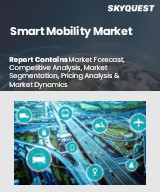
스마트 모빌리티 세계 시장 규모는 2023년에 662억 달러, 2024년 800억 4,000만 달러에서 2032년에는 3,653억 4,000만 달러에 이르고 CAGR 20.9%를 보일 전망입니다.
세계 스마트 모빌리티 시장은 급속한 도시화와 이에 따른 교통 혼잡, 이산화탄소 배출에 대한 환경 문제 등의 이슈로 인해 점점 더 큰 성장을 거듭하고 있습니다. 소비자들이 편의성, 효율성, 지속가능성을 우선시함에 따라 혁신적인 운송 솔루션을 채택하는 방향으로의 전환이 두드러지게 나타나고 있습니다. 비용 효율적인 선택은 개인과 기업 모두에 대한 매력을 높이고 전반적인 운송 효율성을 촉진합니다. 첨단운전자보조시스템(ADAS)를 비롯한 첨단기술은 교통안전 향상과 역동적인 사용자 경험 제공에 중요한 역할을 하고 있습니다. 또한, 도시 인구 증가는 교통 흐름을 최적화하기 위해 실시간 데이터를 효과적으로 활용하는 스마트 교통 관리 시스템에 대한 수요를 증가시키고 있습니다. 또한, 전기자동차의 급증, 자율주행차 개발, Mobility-as-a-Service 플랫폼의 통합으로 유연한 교통 솔루션이 강화되면서 시장은 큰 성장 기회를 발견하고 있습니다.
Global Smart Mobility Market size was valued at USD 66.2 billion in 2023 and is poised to grow from USD 80.04 billion in 2024 to USD 365.34 billion by 2032, growing at a CAGR of 20.9% during the forecast period (2025-2032).
The global smart mobility market is increasingly driven by rapid urbanization and the associated challenges such as traffic congestion and environmental concerns regarding carbon emissions. As consumers prioritize convenience, efficiency, and sustainability, there is a notable shift towards adopting innovative transport solutions. Cost-effective options enhance appeal for both individuals and businesses, promoting overall transportation efficiency. Advanced technologies, including driver assistance systems, play a crucial role in improving road safety and delivering dynamic user experiences. Additionally, the rising urban population amplifies the demand for smart traffic management systems, which effectively utilize real-time data to optimize traffic flows. The market also sees significant growth opportunities with the surge in electric vehicles, the development of autonomous vehicles, and the integration of Mobility-as-a-Service platforms, enhancing flexible transportation solutions.
Top-down and bottom-up approaches were used to estimate and validate the size of the Global Smart Mobility market and to estimate the size of various other dependent submarkets. The research methodology used to estimate the market size includes the following details: The key players in the market were identified through secondary research, and their market shares in the respective regions were determined through primary and secondary research. This entire procedure includes the study of the annual and financial reports of the top market players and extensive interviews for key insights from industry leaders such as CEOs, VPs, directors, and marketing executives. All percentage shares split, and breakdowns were determined using secondary sources and verified through Primary sources. All possible parameters that affect the markets covered in this research study have been accounted for, viewed in extensive detail, verified through primary research, and analyzed to get the final quantitative and qualitative data.
Global Smart Mobility Market Segments Analysis
Global Smart Mobility Market is segmented by Solution Type, Transport Mode, End User, Technology and region. Based on Solution Type, the market is segmented into Integrated Mobility Platforms, Smart Transportation Solutions, Connected Vehicle Solutions, Mobility as a Service and Traffic Management Systems. Based on Transport Mode, the market is segmented into Public Transport, Private Transport, Shared Mobility, Electric Vehicles and Rail Transport. Based on End User, the market is segmented into Government, Transportation Service Providers, Fleet Operators, Corporate and Individuals. Based on Technology, the market is segmented into Internet of Things, Artificial Intelligence, Blockchain, Big Data Analytics and Cloud Computing. Based on region, the market is segmented into North America, Europe, Asia Pacific, Latin America and Middle East & Africa.
Driver of the Global Smart Mobility Market
A key market driver for the Global Smart Mobility Market is the increasing urbanization and the subsequent need for efficient transportation solutions in densely populated areas. As cities expand and populations grow, traditional transportation infrastructures face significant challenges, leading to traffic congestion, pollution, and limited accessibility. Smart mobility solutions, such as electric vehicles, connected transportation, and smart public transit systems, offer innovative alternatives to enhance mobility, reduce environmental impact, and optimize the use of urban space. These technologies not only improve the overall travel experience but also align with government initiatives aimed at promoting sustainable urban development and reducing carbon footprints.
Restraints in the Global Smart Mobility Market
One of the key market restraints for the global smart mobility market is the high initial investment required for the development and implementation of smart mobility technologies. This includes the costs associated with advanced infrastructure, such as smart traffic management systems, electric vehicle charging stations, and integrated transport solutions. Additionally, regulatory challenges and the need for collaboration among various stakeholders-such as government agencies, private enterprises, and technology providers-can complicate and delay the adoption of smart mobility solutions. These financial and operational hurdles may deter investment and slow down the market's growth potential in various regions.
Market Trends of the Global Smart Mobility Market
The global smart mobility market is experiencing a significant transformation, driven by advancements in artificial intelligence (AI) that enhance urban transportation systems. AI is facilitating the rise of autonomous vehicles, which improve safety and efficiency with innovative features like adaptive cruise control and self-parking. Moreover, AI optimizes traffic management through real-time data analytics, enabling smarter signal timing and congestion reduction. Smart city initiatives are leveraging AI to refine public transit scheduling and predictive maintenance, ultimately enriching the overall commuting experience. This confluence of technologies heralds a shift towards more sustainable, efficient, and safe urban mobility solutions, indicating robust growth in the sector.